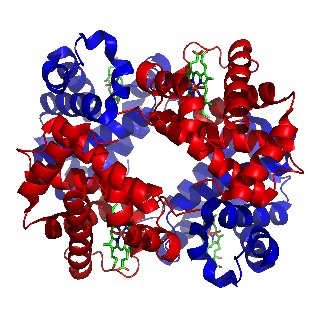B.2 Proteins & enzymes
Written specifically for students to provide help and support for the IB Diploma chemistry programme this page provides full coverage of the syllabus content of Option B - sub topic B.2. It encourages you to think critically and provides many questions with full worked answers so that you can monitor and improve your knowledge and understanding.


 Learning outcomes
Learning outcomes
After studying this topic you should be able to:
 Understand:
Understand:
- Proteins are polymers of condensed 2-amino acids residues bonded by carboxamide links (also known as amide links or peptide bonds).
- 2-amino acids are amphoteric and exist as zwitterions, cations and anions depending upon the pH.
- The structures of proteins are diverse and described at the primary, secondary,tertiary and quaternary levels.
- The three-dimensional shape of a protein determines its role in structural components or in metabolic processes.
- The majority of enzymes are proteins and act as catalysts by binding specifically to the substrate at the active site.
- Since enzyme activity is dependent on its conformation, it is sensitive to changes in temperature and pH and also to the presence of heavy metal ions.
- Separation by chromatography is based on different physical and chemical principles.
Apply your knowledge to:
- Deduce the structural formulas of reactants and products in condensation reactions of amino acids, and hydrolysis reactions of peptides.
- Explain the solubilities and melting points of amino acids in terms of zwitterions.
- Apply the relationships between charge, pH and isoelectric point for amino acids and proteins.
- Describe the four levels of protein structure, including the origin and types of bonds and interactions involved.
- Deduce and interpret graphs of enzyme activity involving changes in substrate concentration, pH and temperature.
- Explain the processes of paper chromatography and gel electrophoresis used to separate and identify amino acids and proteins.
Relationships & vocabulary
Nature of science
The conclusion that DNA, and not protein (as originally thought), carries the information for inheritance is an example of collaboration and peer review achieved after experimental work on different continents.
International-mindedness
The Universal Protein Resource (UniProt), a consortium of bioinformatics institutes, acts as a resource for the scientific community. It provides high-quality, comprehensive, and freely accessible data on protein sequence and functional information.
Vocabulary
| 2-amino acid | zwitterion | isoelectric point | polypeptide |
| peptide bond | quaternary structure | electrophoresis | substrate |
| enzyme | electrophoresis | ninhydrin |
Learning slides
You can use this slide gallery for learning or for reviewing concepts and information. It covers all the key points in the syllabus for this sub-topic.
Something to think about
This topic requires you to understand the primary, secondary, tertiary and quaternary structures of proteins. You can easily understand how the primary structure is obtained by hydrolysing the protein and then analysing the amino acid sequence. However how can the 3-D structure of proteins be obtained unequivocally?
In 1962 Max Perutz was awarded the Nobel prize for the determining the structure of haemoglobin, the first 3-D structure of any protein to be elucidated. The prize was also awarded to John Kendrew, who worked closely with Perutz, and who later determined the structure of another protein, myoglobin, which carries oxygen to muscles.

Image of haemoglobin by Richard Wheeler
(Released under the GNU Free Documentation License)
Max Perutz had been working on the problem using X-rays since 1937. He was able to obtain good X-ray images but the problem was interpreting them. It was finally solved by using the technique of isomorphous replacement. This involved introducing a heavy metal atom such as mercury into the haemoglobin, which subtly altered the X-ray pattern. By analysing these alterations the first 3-D structure of a protein was deduced in 1959.
Since then the structures of many different proteins have been determined and are held on a data base called the Protein Data Bank. Modern methods of determining protein structures involve X-ray crystallography, NMR spectroscopy, and electron microscopy with each having its strengths and weaknesses. In fact, even now it is still very difficult to be absolutely certain about whether a proposed structure is actually correct. In a nice Nature of Science statement the PDB itself says,
“When looking at PDB entries, it is always good to be a bit critical. Keep in mind that the structures in the PDB archive are determined using a balanced mixture of experimental observation and knowledge-based modelling. It often pays to take a little extra time to confirm for yourself that the experimental evidence for a particular structure supports the model as represented and the scientific conclusions based on the model.”
Test your understanding of this topic
(Note that your teacher may have restricted your access to some or all of these questions and worked answers if they are going to use them as a class test or set them as an assignment.)
For ten 'quiz' questions (for quick testing of knowledge and understanding with the answers explained) see MC test: Proteins & enzymes.
For short-answer questions see Proteins & enzymes questions together with the worked answers on a separate page Proteins & enzymes answers.
More resources
1. Two very short but succinct videos giving visual representations of the the primary, secondary, tertiary and quarternary structures of proteins. You could compare the two videos and state what else they could contain to make the chemistry more complete.
2. A search for proteins on the Internet produces some interesting 'health conscious' links. One that has some information that might be useful is by Dr Friedli ( a yoga expert!)
3. How to separate proteins experimentally using polyacrylamide gel electrophoresis (PAGE).
4. A good video from the RCSB Protein Data Bank on how enzymes work.

 IB Docs (2) Team
IB Docs (2) Team 
































